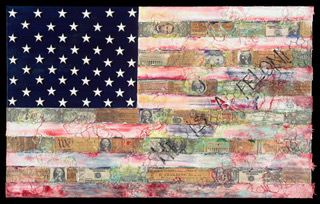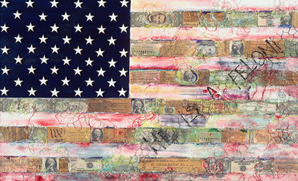L. Scooter Morris doesn’t just paint. She constructs. She sculpts. She captures moments most people wouldn’t even notice and shapes them into something that lingers. A sensory illusionist, Morris takes the ephemeral—an impression, a texture, a social flashpoint—and gives it form. Her “Sculpted Paintings” go beyond the flat surface. They blend media, light, and texture to create visual conversations. Her work isn’t just about beauty; it’s about what beauty can carry. Especially in times like these, where justice feels fragile and progress feels like a push-pull, Morris is offering a mirror, or maybe a warning. Each piece dares to ask something deeper. And often, it demands an answer.
One of her most telling works, Felon (2025), offers just that kind of reckoning.

At first glance, Felon reads as an American flag. But stay with it longer and that familiarity begins to unravel. The flag is there, yes—stars, stripes, the red-white-and-blue—but those stripes aren’t just painted lines. They’re made of currency. Real bills. American dollars. And the ink? It bleeds. It smudges. It looks raw. The stars feel colder than usual, the stripes more volatile. Overlaid are threads, washes, shadows. It’s not patriotic decoration—it’s a provocation.
Morris has said this work is her “insight into the progression of who we are and where we have come from.” It’s a painting, but also a history lesson. Or maybe a confrontation. Layered into the flag are pieces of documents and artifacts we’ve come to associate with identity, authority, and power. You see snippets of the Constitution, old banknotes, references to incarceration, and even the faint suggestion of fingerprints.
The word “FELON” is scrawled across the stripes, almost like a brand. This isn’t subtle. It’s intentional. The label cuts across the icon of national pride. It challenges the viewer to ask who gets called a felon in this country—and why. Who writes the rules, and who gets punished for breaking them?
Morris uses acrylics and mixed media like a builder. Nothing in the work is just paint for paint’s sake. The surface is dense. There’s a physicality to it that pushes back against the passivity of viewing. You almost want to touch it, even though it looks like it might burn. That’s the push of her sculpted technique—using surface to spark a deeper look inward.
What’s clever, and haunting, is how Morris fuses contradiction. Patriotism and punishment. History and hurt. The familiar icon of a nation with the bruises of its past baked in. Felon suggests that America isn’t just a place; it’s an idea under revision. And everyone—citizens, lawmakers, artists—is complicit in what happens next.
Morris’s commentary doesn’t scream. It hums. There’s a tension that never fully resolves, and that’s the point. The work isn’t about resolution; it’s about reflection. Morris acknowledges the current climate, a time where authoritarianism creeps and democracy strains. And yet, there’s resistance. There’s a push to reclaim. Felon sits at that intersection.
She doesn’t offer a solution. But she offers the question. And maybe that’s the work of art in this era—not to wrap things up in a clean message, but to leave the mess in view and dare us to care.
There’s something personal about how Morris frames national trauma. You sense that she’s not just talking about “us” as a country in the abstract. She’s talking about individuals. About choices. About silence and action. The felon isn’t just someone else. It could be any of us, depending on which way the political wind blows.
Felon is bold, but not self-congratulatory. It’s not about shock value. It’s about staying with discomfort long enough to learn something.
For Morris, beauty and meaning go hand in hand. And in Felon, they do more than coexist. They wrestle. They bruise each other. They make you pause. That’s what makes this painting land—not with polish, but with grit. And grit is what we need right now.


